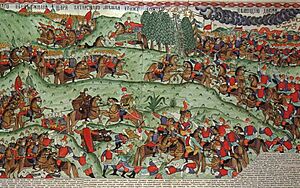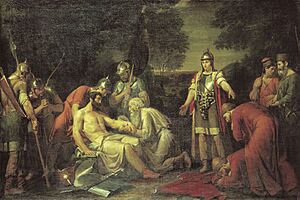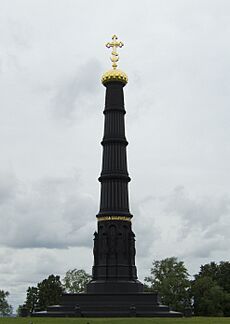Battle of Kulikovo facts for kids
Quick facts for kids Battle of Kulikovo |
|||||||
|---|---|---|---|---|---|---|---|
| Part of the Great Troubles | |||||||
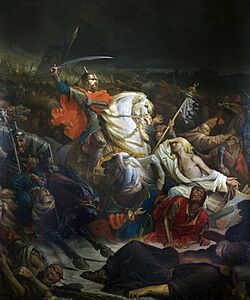 "The Battle of Kulikovo" (1849). Painting by Adolphe Yvon. |
|||||||
|
|||||||
| Belligerents | |||||||
|
|
||||||
| Commanders and leaders | |||||||
| Strength | |||||||
| 30,000–50/60,000–150,000 | 30,000–100,000–200,000–300,000 | ||||||
The Battle of Kulikovo (Russian: Куликовская битва, romanized: Kulikovskaya bitva) was a huge fight between the forces of Mamai and Russian forces. The Russian army was led by Grand Prince Dmitry of Moscow. This important battle happened on 8 September 1380, at Kulikovo Field near the Don River in what is now Tula Oblast, Russia. Dmitry won the battle, and after that, he became known as Donskoy, which means "of the Don".
Even though this victory did not immediately end Mongol rule over Russia, it is seen as a major turning point. It marked the beginning of the end for Mongol power and the rise of Moscow's influence. The battle helped Moscow become stronger and unite other Russian lands. It is also considered the start of the Russian nation coming together as one. Today, the victory at Kulikovo is celebrated in Russia as a Day of Military Honour.
Contents
Why the Battle Happened
Mongol Rule and Moscow's Rise
For a long time, many small Russian areas were under the control of the Golden Horde, a part of the Mongol Empire. This started after the Mongol invasion of Rus' in the 1200s. During this period, the Principality of Moscow began to grow stronger. Moscow often fought with its neighbors over land. For example, in 1300, Moscow took the city of Kolomna from another area called Ryazan.
Troubles in the Golden Horde
After 1359, the Golden Horde faced big problems, known as the Great Troubles. Many leaders fought for power. A powerful warlord named Mamai took control of the western part of the Golden Horde. Mamai was not from the main Mongol ruling family (the Genghisids). This made his power weak, so he had to constantly fight to keep it. While the Golden Horde was having these internal wars, new strong areas like the Grand Duchy of Lithuania and the Principality of Moscow were growing.
Dmitry's Growing Power
In 1359, the Prince of Moscow, Ivan II, died. His son, Dmitry, was only nine years old. The Mongol Khan tried to give the main Russian throne (of Vladimir) to another prince. But Moscow's leaders used force and money to make the other princes give up their claims. By 1365, Moscow had secured its claim to the Grand Duchy of Vladimir.
Dmitry also faced challenges from the Prince of Tver, Mikhail. Mikhail got help from Lithuania and even a special order from Mamai to rule Vladimir. But Moscow's army stopped him from entering Vladimir. After more fighting, Dmitry made Tver accept him as the main Russian prince. Tver even promised to help Moscow in wars against the Mongols.
Open Conflict with Mamai
The open fight between Dmitry and Mamai started around 1374. The exact reasons are not fully known. People believe Mamai was losing power in the Golden Horde and demanded more and more money from Russian lands. In the next few years, Mamai's forces attacked Dmitry's allies. Moscow's troops also fought back, even taking the city of Bolghar in 1377. However, Mamai's forces defeated an army from Nizhny Novgorod at the Battle on Pyana River that same year.
In 1378, Mamai sent a large army to make Prince Dmitry obey him. But Dmitry's army won a big victory at the Battle of the Vozha River. Meanwhile, another Mongol leader, Tokhtamysh, was gaining power in the eastern Golden Horde. He wanted to unite the whole Horde.
In 1380, even with the threat from Tokhtamysh, Mamai decided to lead his army against Moscow himself. He made an alliance with Prince Jogaila of Lithuania. The Prince of Ryazan, Oleg, had been defeated by Mamai before. So, Oleg sided with Mamai, though some historians disagree on this. Mamai set up his army near the Don River, waiting for his allies to arrive.
Getting Ready for Battle
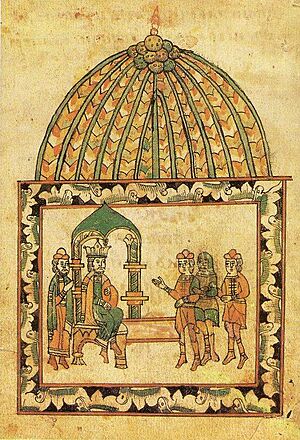
The Russian March
In August 1380, Prince Dmitry learned that Mamai's army was coming. Some say Oleg of Ryazan sent him the message. Dmitry quickly gathered his army in Kolomna. Mamai's messengers came to Dmitry, demanding more tribute money. Dmitry agreed to pay, but only the amount from their old agreement.
In Kolomna, Dmitry got more information about Mamai's plans and Jogaila's approaching army. So, on August 20, Dmitry moved his army west. They crossed the Oka River on August 24–25 and headed south towards Mamai. By September 6, the Russian army reached the Don River. There, they reorganized their forces. At a meeting, Dmitry decided to cross the Don River before the enemy armies could join up. This was a risky move because it meant they could not easily retreat if they lost.
The Armies
It is hard to know the exact number of soldiers in Dmitry's army. Early records do not give many details. Later stories give very large numbers, like 150,000 or even 400,000 soldiers. However, historians today believe these numbers are too high. It was likely a very large army for that time, perhaps around 30,000 to 60,000 soldiers. It included fighters from most of North-Eastern Russia. Some princes from Smolensk and other areas also joined. It is also likely that Jogaila's rebellious brothers, Andrei of Polotsk and Dmitri of Bryansk, fought with Dmitry.
The number of Mamai's forces is also unclear in old records. They often say the Mongol army was "innumerable." Mamai's allies, Prince Oleg of Ryazan and Prince Jogaila of Lithuania, arrived too late to join the battle.
The Battle Begins
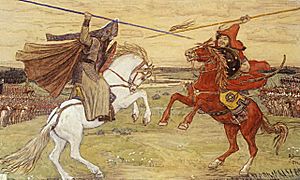
On September 7, Prince Dmitry was told that Mamai's army was close. On the morning of September 8, in a thick fog, the Russian army crossed the Don River. The bridges were then destroyed. September 8 was a special day, as it was a religious holiday. The army took its battle positions on a clear field near the Nepryadva River. Soon after, the Mongol forces appeared and formed their own battle lines.
Russian Battle Plan
The Russian army was set up in six main groups, called "regiments." These included a Patrol, a Forward group, two "Right Hand" and "Left Hand" groups, a Large regiment, and a hidden Ambush regiment. Each regiment had smaller units. The battlefield was narrow, so the armies could not spread out widely. Ravines and thick bushes protected the sides of the Russian army, making it hard for the Mongols to attack from the flanks.
The Ambush regiment, led by Vladimir the Bold and Dmitry Bobrok, was hidden in an oak grove behind the main Russian lines. Prince Dmitry himself went to the front lines. He even swapped clothes and horses with a trusted soldier named Mikhail Brenok. This way, Dmitry could fight like a regular soldier and not be easily recognized.
The Duel
The battle started with a single combat between two champions. The Russian champion was Alexander Peresvet, a monk. The Mongol champion was Temir-Murza (also known as Chelubey). In their first clash, both champions struck each other with their spears. Both fell from their horses and died. It was unclear whose side this duel predicted would win.
The Main Fight

After the first small clashes, the main armies fought each other. This happened around 10:35 AM. It was a very fierce and long fight. Many soldiers died on both sides. The battlefield was so tight that the Mongols could not use their usual fast, flanking attacks.
Slowly, the Mongols began to gain the upper hand. They broke through to the Large Regiment's flag, knocking it down. Boyar Brenok, who was leading the Large Regiment, was killed. The "Left Hand" regiment was also pushed back, and some new Moscow soldiers panicked. It looked like the Russian army was about to be defeated. The Mongols used all their strength to push forward.
The Turning Point
Just when it seemed the Russians would lose, the hidden Ambush regiment launched a surprise attack on the Mongol flank. The Mongol soldiers and horses were tired from the long battle. They could not stand against the fresh Russian forces. The Mongol lines broke apart. The Russians then chased the fleeing Mongols for over 50 kilometers (about 30 miles).
After the Battle
The battle caused huge losses for both sides. Many Russian commanders were killed. Grand Prince Dmitry himself survived, but he was wounded and very tired. His personal guards were all killed or scattered. For six days, the victorious Russian army stayed on the battlefield, surrounded by the dead.
When Prince Jogaila of Lithuania heard about Mamai's defeat, he turned his army around and went back home. People from Ryazan attacked and robbed some of the Russian soldiers returning from the battle. Prince Dmitry of Moscow prepared to punish Ryazan, but Prince Oleg of Ryazan fled. Oleg soon returned to power, but he had to accept Dmitry as his ruler and sign a peace treaty.
Mamai's puppet Khan, Mukhammad-Bulek, was killed in the battle. Mamai escaped to a Genoese city called Caffa in Crimea. He tried to gather a new army, but his nobles left him to join his rival, Tokhtamysh Khan. Mamai fled again to Caffa and was killed there. The war with Moscow completely destroyed Mamai's power. Tokhtamysh gained full control of the Golden Horde, ending a 20-year split.
Prince Dmitry, now known as Donskoy, did not become fully independent from the Golden Horde right away. In 1382, Khan Tokhtamysh attacked Moscow. He captured and burned the city, forcing Dmitry to accept him as his ruler. However, the victory at Kulikovo was a clear sign that Mongol power was weakening. Over the next century, Moscow grew stronger and took control of other Russian areas. Russian rule under the Golden Horde officially ended in 1480, a century after the Battle of Kulikovo. This happened after another Mongol invasion was stopped at the great stand on the Ugra River.
Battle's Importance
Historians have different ideas about how important the Battle of Kulikovo was:
- Many Russian historians see it as the first big step towards Russia becoming free from Mongol rule.
- Some religious historians see it as a fight between Christian Russians and non-Christians.
- Historian Sergey Solovyov believed it was very important for Eastern Europe. He saw it as stopping another invasion from Asia, similar to other famous battles in Europe.
- Other historians think the battle's importance is sometimes exaggerated. They see it as just a smaller conflict within the Golden Horde.
- Historian Lev Gumilev thought Mamai represented outside interests, especially from Western Europe, because he had many Genoese soldiers. Gumilev believed the Moscow army supported the rightful Mongol ruler, Tokhtamysh. He famously said, "Russians went to the Kulikovo field as citizens of various principalities and returned as a united Russian nation."
- The battle is also seen as an early example of a Russian military tactic called maskirovka, which means using deception. It is taught in Russian military schools.
Images for kids


